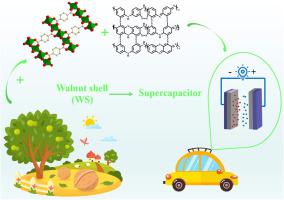Colloids and Surfaces A: Physicochemical and Engineering Aspects ( IF 4.9 ) Pub Date : 2021-09-25 , DOI: 10.1016/j.colsurfa.2021.127584 Junye Zhang 1 , Hao Guo 1 , Fan Yang 1 , Mingyue Wang 1 , Hao Zhang 1 , Tingting Zhang 1 , Lei Sun 1 , Meng Yang 1 , Wu Yang 1

|
In this paper, novel hybrid nanomaterials constituting carbonized biomass materials derived from walnut shells and metal-organic framework (MOF) have been researched as a new class of renewable supercapacitor materials for electrochemical energy storage. One synthetic route is employed to grow Ni-MOF in the peripheries and channels of walnut shells derived carbon (WS), which had been carbonized previously by heat treatment in air at 850 °C to produce a highly porous network, and vulcanized polyaniline (SPANI) is used as a dummy plate preventing the agglomeration of MOFs and a wire connecting WS and MOFs, which easily improves the electron transfer and enhances the conductivity of the electrode material. The specific capacitance of the obtained WS@Ni-MOF composite is up to 4 times that of the biochar at the current density of 1 A g-1. The connection of SPANI also obviously accelerates the transfer of electrolyte ions. The resulting specific capacitance could reach 14 times of the biochar and exhibit high cycle stability (retention rate of 90.4% after 20000 cycles). In addition, the assembled asymmetrical supercapacitor (ASC) shows a high energy density of 34.79 Wh kg-1 at the power density of 824 W kg-1. This work provides a brilliant renewable candidate for the excellent energy storage device and a promising route design strategy for preparation of high performance and long life electrode materials.
中文翻译:

核桃壳衍生的多孔碳与 Ni-MOF/SPANI 复合材料集成用于高性能超级电容器
在本文中,研究了由核桃壳衍生的碳化生物质材料和金属有机骨架 (MOF) 构成的新型杂化纳米材料,作为一种新型的可再生超级电容器材料,用于电化学储能。一种合成路线用于在核桃壳衍生碳 (WS) 的外围和通道中生长 Ni-MOF,该碳之前已通过在 850 °C 的空气中热处理碳化以产生高度多孔的网络,以及硫化聚苯胺 (SPANI) )用作防止MOFs团聚的中间板和连接WS和MOFs的导线,容易改善电子转移并增强电极材料的导电性。所得WS@Ni-MOF复合材料在1 A电流密度下的比电容高达生物炭的4倍 克-1。SPANI的连接也明显加速了电解质离子的转移。由此产生的比电容可以达到生物炭的 14 倍,并表现出高循环稳定性(20000 次循环后保留率为 90.4%)。此外,组装的非对称超级电容器(ASC)在824 W kg -1的功率密度下显示出34.79 Wh kg -1的高能量密度。这项工作为优异的储能装置提供了一个出色的可再生候选者,并为制备高性能和长寿命的电极材料提供了有前途的路线设计策略。











































 京公网安备 11010802027423号
京公网安备 11010802027423号